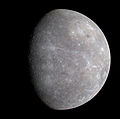Fiila:Mercury in color - Prockter07 centered.jpg

Ovdačájáhusa sturrodat: 605 × 600 piksela (govvačuoggá). Andre oppløsninger: 242 × 240 piksela (govvačuoggá) | 484 × 480 piksela (govvačuoggá) | 775 × 768 piksela (govvačuoggá) | 1 033 × 1 024 piksela (govvačuoggá) | 1 991 × 1 974 piksela (govvačuoggá).
Álgovuolggalaš fiila (1 991 × 1 974 piksela (govvačuoggá), fiilasturrodat: 1,72 MiB, MIME-tiipa: image/jpeg)
Fiilla historjá
Go deaddilat beaivemeari, oainnat makká fiila lei dalle.
| Beaivemearri/Áigi | Govaš | Mihtut | Geavaheaddji | Kommentára | |
|---|---|---|---|---|---|
| dálá | geassemánnu 4 b. 2008 dii. 12.49 |  | 1 991 × 1 974 (1,72 MiB) | Papa Lima Whiskey | {{Information |Description=Full color image of from first MESSENGER flyby |Source=NASA/JPL [http://messenger.jhuapl.edu/gallery/sciencePhotos/image.php?page=1&gallery_id=2&image_id=143] |Date=2008-01-30 |Author=NASA/[[w:Applied Physics Laborato |
Liŋkkat
Čuovvovaš siidduin lea liŋka dán fiilai:
Fiilla vuogádatviidosaš geavaheapmi
Følgende andre wikier bruker denne filen:
- Geavaheapmi prošeavttas ab.wikipedia.org
- Geavaheapmi prošeavttas af.wikipedia.org
- Geavaheapmi prošeavttas ang.wikipedia.org
- Geavaheapmi prošeavttas anp.wikipedia.org
- Geavaheapmi prošeavttas an.wikipedia.org
- Geavaheapmi prošeavttas ar.wikipedia.org
- عطارد
- كوكب
- بوابة:المجموعة الشمسية
- مارينر 10
- بيبيكولومبو
- قالب:عطارد
- عبور عطارد
- قالب:المجموعة الشمسية
- قائمة أجرام المجموعة الشمسية مرتبة حسب الحجم
- قائمة أجرام النظام الشمسي المستديرة بالجاذبية
- ويكيبيديا:هل تعلم/قائمة/68
- حوض كالوريس
- برنامج مارينر
- اكتشاف واستكشاف النظام الشمسي
- قائمة أنواع الكواكب
- مستخدم:محمد 19951/ملعب13
- عبور عطارد من الزهرة
- عبور الشمس
- بوابة:المجموعة الشمسية/قوالب
- جيولوجيا عطارد
- استكشاف عطارد
- مستخدم:ASammour/صور مختارة
- ويكيبيديا:هل تعلم/قائمة شاملة
- حقل عطارد المغناطيسي
- 1981 ميداس
- حفرة فلايانو
- قالب:بذرة كوكب عطارد
- غلاف عطارد الجوي
- عطارد في الخيال
- Geavaheapmi prošeavttas ar.wiktionary.org
- Geavaheapmi prošeavttas arz.wikipedia.org
- Geavaheapmi prošeavttas ast.wikipedia.org
- Geavaheapmi prošeavttas as.wikipedia.org
- Geavaheapmi prošeavttas avk.wikipedia.org
- Geavaheapmi prošeavttas awa.wikipedia.org
- Geavaheapmi prošeavttas bat-smg.wikipedia.org
- Geavaheapmi prošeavttas ba.wikipedia.org
Vis mer global bruk av denne filen.




